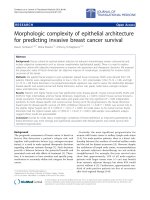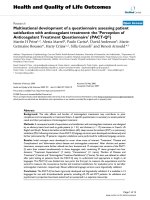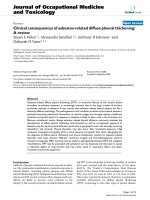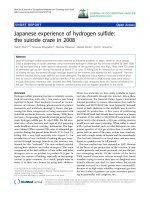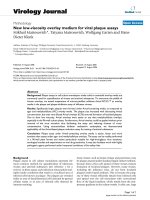Báo cáo hóa học: " New inequalities of hermite-hadamard type for convex functions with applications" pptx
Bạn đang xem bản rút gọn của tài liệu. Xem và tải ngay bản đầy đủ của tài liệu tại đây (275.32 KB, 11 trang )
RESEARCH Open Access
New inequalities of hermite-hadamard type for
convex functions with applications
Havva Kavurmaci
*
, Merve Avci and M Emin Özdemir
* Correspondence:
Aatatürk University, K.K. Education
Faculty, Department of
Mathematics, 25240, Campus,
Erzurum, Turkey
Abstract
In this paper, some new inequalities of the Hermite-Hadamard type for functions
whose modulus of the derivatives are convex and applications for special means are
given. Finally, some error estimates for the trapezoidal formula are obtained.
2000 Mathematics Subject Classiffication. 26A51, 26D10, 26D15.
Keywords: Convex function, Hermite-Hadamard inequality, Hölder inequality, Power-
mean inequality, Special means, Trapezoidal formula
1. Introduction
A function f : I ® ℝ is said to be convex function on I if the inequality
f
(
αx +
(
1 − α
)
y
)
≤ αf
(
x
)
+
(
1 − α
)
f
(
y
),
holds for all x, y Î I and a Î [0,1].
One of the most famous inequalit y for convex functi ons is so called Hermite-Hada-
mard’sinequalityasfollows:Letf : I ⊆ ℝ ® ℝ be a convex function defined on the
interval I of real numbers and a, b Î I, with a <b. Then:
f
a + b
2
≤
1
b − a
b
a
f (x)dx ≤
f (a)+f (b)
2
.
(1:1)
In [1], the following theorem which was obtained by Dragomir and Agarwal contains
the Hermite-Hadamard type integral inequality.
Theorem 1. Let f : I° ⊆ ℝ ® ℝ be a differentiable mapping on I°, a, b Î I° with a <b.
If |f’| is convex on [a, b], then the following inequality holds:
f (a)+f (b)
2
−
1
b − a
b
a
f (u)du
≤
(b − a)(|f
(a)| + |f
(b)|)
8
.
(1:2)
In [2] Kirmaci, Bakula, Özdemir and Pečarić proved the following theorem.
Theorem 2. Let f : I ® ℝ, I ⊂ ℝ be a differentiable function on I° such that f’ Î L [a,
b], where a, b Î I, a <b. If |f’|
q
is concave on [a, b] for some q >1,then:
Kavurmaci et al. Journal of Inequalities and Applications 2011, 2011:86
/>© 2011 Kavurmaci et al; licensee Springer. This is an Open Access article distributed under the terms of the Creative Commons
Attribution License ( g/licenses/by/2.0), which perm its unrestricted use, distribution, and reproduction in
any medium, pro vided the original work is properly cited.
f (a)+f (b)
2
−
1
b − a
b
a
f (u)du
≤
b − a
4
q − 1
2q − 1
q−1
q
f
a +3b
4
+
f
3a + b
4
.
(1:3)
In [3], Kirmaci obtained the following theorem and corollary related to this theorem.
Theorem 3. Let f : I° ⊂ ℝ ® ℝ be a differentiable mapping on I°, a, b Î I° with a <b
and let p >1.If the mapping |f’|
p
is concave on [a, b], then we have
f (ca +(1− c)b)(B − A)+f (a)(1 − B)+f (b)A −
1
b − a
b
a
f (x)dx
≤ ( b − a)
K
f
aT + b(K − T)
K
+ M
f
aN + b(M − N)
M
where
K =
A
2
+(c − A)
2
2
, T =
A
3
+ c
3
3
−
Ac
2
2
, M =
(B − c)
2
+(1− B)
2
2
,
N =
B
3
+ c
3
+1
3
− (1 + c
2
)
B
2
.
Corollary 1. Under the assumptions of Theorem 3 with
A = B = c =
1
2
, we have
f (a)+f (b)
2
−
1
b − a
b
a
f (x)dx
≤
(b − a)
8
f
5a + b
6
+
f
a +5b
6
.
(1:4)
For recent results and generalizations concerning Hermite-Hadamard’s inequality see
[1]-[5] and the references given therein.
2. The New Hermite-Hadamard Type Inequalities
In order to prove our main theorems, we first prove the following lemma:
Lemma 1. Let f : I ⊆ ℝ ® ℝ be a differentiable mapping on I°, where a, b Î I with a
<b. If f’ Î L [a, b], then the following equality holds:
(b − x)f(b)+(x − a)f (a)
b − a
−
1
b − a
b
a
f (u)du
=
(x − a)
2
b − a
1
0
(t − 1)f
(tx +(1− t)a)dt +
(b − x)
2
b − a
1
0
(1 − t)f
(tx +(1− t)b)dt
.
Proof. We note that
J
=
(x − a)
2
b − a
1
0
(t − 1)f
(tx +(1− t)a)dt
+
(b − x)
2
b − a
1
0
(1 − t)f
(tx +(1− t)b)dt
.
Kavurmaci et al. Journal of Inequalities and Applications 2011, 2011:86
/>Page 2 of 11
Integrating by parts, we get
J
=
(x − a)
2
b − a
(t − 1)
f (tx +(1− t)a)
x − a
1
0
−
1
0
f (tx +(1− t)a)
x − a
dt
+
(b − x)
2
b − a
(1 − t)
f (tx +(1− t)b)
x − b
1
0
+
1
0
f (tx +(1− t)b)
x − b
dt
=
(x − a)
2
b − a
f (a)
x − a
−
1
(x − a)
2
x
a
f (u)du
+
(b − x)
2
b − a
−
f (b)
x − b
+
1
(x − b)
2
x
b
f (u)du
=
(b − x)f (b)+(x − a)f (a)
b − a
−
1
b − a
b
a
f (u)du.
□
Using the Lemma 1 the following results can be obtained.
Theorem 4. Let f : I ⊆ ℝ ® ℝ be a differentiable mapping on I° such that f’ Î L [a,
b], where a, b Î Iwitha<b. If |f’ | is convex on [a, b], then the fol lowing inequality
holds:
(b − x)f (b)+(x − a)f (a)
b − a
−
1
b − a
b
a
f (u)du
≤
(x − a)
2
b − a
|f
(x)| +2|f
(a)|
6
+
(b − x)
2
b − a
|f
(x)| +2|f
(b)|
6
for each x Î [a, b].
Proof. Using Lemma 1 and taking the modulus, we have
(b − x)f (b)+(x − a)f (a)
b − a
−
1
b − a
b
a
f (u)du
≤
(x − a)
2
b − a
1
0
(1 − t)|f
(tx +(1− t)a)|dt
+
(b − x)
2
b − a
1
0
(1 − t)|f
(tx +(1− t)b)|dt.
Since |f’| is convex, then we get
(b − x)f (b)+(x − a)f (a)
b − a
−
1
b − a
b
a
f (u)du
≤
(x − a)
2
b − a
1
0
(1 − t)[t|f
(x)| +(1− t)|f
(a)|]dt
+
(b − x)
2
b − a
1
0
(1 − t)[t|f
(x)| +(1− t)|f
(b)|]dt
=
(x − a)
2
b − a
|f
(x)| +2|f
(a)|
6
+
(b − x)
2
b − a
|f
(x)| +2|f
(b)|
6
which completes the proof. □
Kavurmaci et al. Journal of Inequalities and Applications 2011, 2011:86
/>Page 3 of 11
Corollary 2. In Theorem 4, if we choose
x =
a+
b
2
we obtain
f (a)+f (b)
2
−
1
b − a
b
a
f (u)du
≤
b − a
12
|f
(a)| +
f
a + b
2
+ |f
(b)|
.
Remark 1. In Corollary 2, using the convexity of |f’| we have
f (a)+f (b)
2
−
1
b − a
b
a
f (u)du
≤
b − a
8
(|f
(a)| + |f
(b)|
)
which is the inequality in (1.2).
Theorem 5. Let f : I ⊆ ℝ ® ℝ be a differentiable mapping on I° such that f’ Î L [a,
b], where a, b Î I with a <b. If
|f
|
p
p−1
is conve x on [a, b] and for some fixed q >1,then
the following inequality holds:
(b − x)f (b)+(x − a)f (a)
b − a
−
1
b − a
b
a
f (u)du
≤
1
p +1
1
p
1
2
1
q
×
⎡
⎢
⎣
(x − a)
2
|f
(a)|
q
+ |f
(x)|
q
1
q
+(b − x)
2
|f
(x)|
q
+ |f
(b)|
q
1
q
b − a
⎤
⎥
⎦
for each x Î [a, b] and
q =
p
p
−1
.
Proof. From Lemma 1 and using the well-known Hölder integral inequality, we have
(b − x)f (b)+(x − a)f (a)
b − a
−
1
b − a
b
a
f (u)du
≤
(x − a)
2
b − a
1
0
(1 − t)|f
(tx +(1− t)a)|dt
+
(b − x)
2
b − a
1
0
(1 − t)|f
(tx +(1− t)b)|dt
≤
(x − a)
2
b − a
1
0
(1 − t)
p
dt
1
p
1
0
|f
(tx +(1− t)a)|
q
dt
1
q
+
(b − x)
2
b − a
1
0
(1 − t)
p
dt
1
p
1
0
|f
(tx +(1− t)b)|
q
dt
1
q
.
Since
|
f
|
p
p−1
is convex, by the Hermite-Hadamard’s inequality, we have
1
0
|f
(tx +(1− t)a)|
q
dt ≤
|f
(a)|
q
+ |f
(x)|
q
2
and
1
0
|f
(tx +(1− t)b)|
q
dt ≤
|f
(b)|
q
+ |f
(x)|
q
2
,
Kavurmaci et al. Journal of Inequalities and Applications 2011, 2011:86
/>Page 4 of 11
so
(b − x)f (b)+(x − a)f (a)
b − a
−
1
b − a
b
a
f (u)du
≤
1
p +1
1
p
1
2
1
q
×
⎡
⎢
⎣
(x − a)
2
|f
(a)|
q
+ |f
(x)|
q
1
q
+(b − x)
2
|f
(x)|
q
+ |f
(b)|
q
1
q
b − a
⎤
⎥
⎦
which completes the proof. □
Corollary 3. In Theorem 5, if we choose
x =
a+b
2
we obtain
f (a)+f (b)
2
−
1
b − a
b
a
f (u)du
≤
b − a
4
1
p +1
1
p
1
2
1
q
×
⎡
⎣
|f
(a)|
q
+
f
a + b
2
q
1
q
+
|f
(b)|
q
+
f
a + b
2
q
1
q
⎤
⎦
≤
b − a
2
1
p +1
1
p
1
2
1
q
(|f
(a)| + |f
(b)|).
The second inequality is obtained using the following fact:
n
k
=1
(a
k
+ b
k
)
s
≤
n
k
=1
(a
k
)
s
+
n
k
=1
(b
k
)
s
for (0 ≤ s <1),a
1
, a
2
, a
3
, , a
n
≥ 0; b
1
, b
2
, b
3
, ,
b
n
≥ 0 with
0 ≤
p−1
p
<
1
, for p >1.
Theorem 6. Let f : I ⊆ ℝ ® ℝ be a differentiable mapping on I° such that f’ Î L [a,
b], where a, b Î Iwitha<b. If |f’|
q
is concave on [a, b], for some fixed q >1,then the
following inequality holds:
(b − x)f (b)+(x − a)f (a)
b − a
−
1
b − a
b
a
f (u)du
≤
q − 1
2q − 1
q−1
q
⎡
⎣
(x − a)
2
f
a+x
2
| +(b − x)
2
|f
b+x
2
b − a
⎤
⎦
for each x Î [a, b].
Proof. As in Theorem 5, using Lemma 1 and the well-known Hölder integral inequal-
ity for q > 1 and
p =
q
q
−1
, we have
Kavurmaci et al. Journal of Inequalities and Applications 2011, 2011:86
/>Page 5 of 11
(b − x)f (b)+(x − a)f (a)
b − a
−
1
b − a
b
a
f (u)du
≤
(x − a)
2
b − a
1
0
(1 − t)|f
(tx +(1− t)a)|dt
+
(b − x)
2
b − a
1
0
(1 − t)|f
(tx +(1− t)b)|dt
≤
(x − a)
2
b − a
1
0
(1 − t)
q
q−1
dt
q−1
q
1
0
|f
(tx +(1− t)a)|
q
dt
1
q
+
(b − x)
2
b − a
1
0
(1 − t)
q
q−1
dt
q−1
q
1
0
|f
(tx +(1− t)b)|
q
dt
1
q
.
Since |f’|
q
is concave on [a, b], we can use the Jensen’s integral inequality to obtain:
1
0
|f
(tx +(1− t)a)|
q
dt =
1
0
t
0
|f
(tx +(1− t)a)|
q
dt
≤
1
0
t
0
dt
f
1
1
0
t
0
dt
1
0
(tx+(1 − t ) a ) dt
q
=
f
a + x
2
q
Analogously,
1
0
|f
(tx +(1− t)b)|
q
dt ≤
f
b + x
2
q
.
Combining all the obtained inequalities, we get
(b − x)f (b)+(x − a)f (a)
b − a
−
1
b − a
b
a
f (u)du
≤
q − 1
2q − 1
q−1
q
⎡
⎣
(x − a)
2
|f
a+x
2
| +(b − x)
2
|f
b+x
2
|
b − a
⎤
⎦
which completes the proof. □
Remark 2. In Theorem 6, if we choose
x =
a+b
2
we have
f (a)+f (b)
2
−
1
b − a
b
a
f (u)du
≤
q − 1
2q − 1
q−1
q
b − a
4
f
3a + b
4
+
f
a +3b
4
which is the inequality in (1.3).
Theorem 7. Let f : I ⊆ ℝ ® ℝ be a differentiable mapping on I° such that f’ Î L [a,
b], where a, b Î Iwitha<b. If |f’|
q
is convex on [a, b] and for some fixed q ≥ 1, then
the following inequality holds:
Kavurmaci et al. Journal of Inequalities and Applications 2011, 2011:86
/>Page 6 of 11
(b − x)f (b)+(x − a)f (a)
b − a
−
1
b − a
b
a
f (u)du
≤
1
2
1
3
1
q
⎡
⎢
⎣
(x − a)
2
|f
(x)|
q
+2|f
(a)|
q
1
q
+(b − x)
2
|f
(x)|
q
+2|f
(b)|
q
1
q
b − a
⎤
⎥
⎦
for each x Î [a, b].
Proof. Suppose that q ≥ 1. From Lemma 1 and using the well-known power-mean
inequality, we have
(b − x)f (b)+(x − a)f (a)
b − a
−
1
b − a
b
a
f (u)du
≤
(x − a)
2
b − a
1
0
(1 − t)|f
(tx +(1− t)a)|dt
+
(b − x)
2
b − a
1
0
(1 − t)|f
(tx +(1− t)b)|dt
≤
(x − a)
2
b − a
1
0
(1 − t)dt
1−
1
q
1
0
(1 − t)|f
(tx +(1− t)a)|
q
dt
1
q
+
(b − x)
2
b − a
1
0
(1 − t)dt
1−
1
q
1
0
(1 − t)|f
(tx +(1− t)b)|
q
dt
1
q
.
Since |f’|
q
is convex, therefore we have
1
0
(1 − t)|f
(tx +(1− t)a)|
q
dt
≤
1
0
(1 − t)
t|f
(x)|
q
+(1− t)|f
(a)|
q
d
t
=
|f
(x)|
q
+2|f
(a)|
q
6
Analogously,
1
0
(1 − t)|f
(tx +(1− t)b)|
q
dt ≤
|f
(x)|
q
+2|f
(b)|
q
6
.
Combining all the above inequalities gives the desired result. □
Corollary 4. In Th eorem 7, choosing
x =
a+b
2
and then using the convexity of |f’|
q
we
have
f (a)+f (b)
2
−
1
b − a
b
a
f (u)du
≤
b − a
8
1
3
1
q
⎡
⎣
2|f
(a)|
q
+
f
a + b
2
q
1
q
+
2|f
(b)|
q
+
f
a + b
2
q
1
q
⎤
⎦
≤
⎛
⎝
3
1−
1
q
8
⎞
⎠
(b − a)(|f
(a)| + |f
(b)|).
Kavurmaci et al. Journal of Inequalities and Applications 2011, 2011:86
/>Page 7 of 11
Theorem 8. Let f : I ⊆ ℝ ® ℝ be a differentiable mapping on I° such that f’ Î L [a,
b], where a, b Î Iwitha<b. If |f’|
q
is concave on [a, b], for some fixed q ≥ 1, then the
following inequality holds:
(b − x)f (b)+(x − a)f (a)
b − a
−
1
b − a
b
a
f (u)du
≤
1
2
⎡
⎣
(x − a)
2
|f
x+2a
3
| +(b − x)
2
|f
x+2b
3
|
b − a
⎤
⎦
.
Proof. First, we note that by the concavity of |f’|
q
and the power-mean inequality,
we have
|f
(
tx +
(
1 − t
)
a
)
|
q
≥ t|f
(
x
)
|
q
+
(
1 − t
)
|f
(
a
)
|
q
.
Hence,
|f
(
tx +
(
1 − t
)
a
)
|≥t|f
(
x
)
| +
(
1 − t
)
|f
(
a
)
|
,
so |f’| is also concave.
Accordingly, using Lemma 1 and the Jensen integral inequality, we have
(b − x)f (b)+(x − a)f (a)
b − a
−
1
b − a
b
a
f (u)du
≤
(x − a)
2
b − a
1
0
(1 − t)|f
(tx +(1− t)a)|dt
+
(b − x)
2
b − a
1
0
(1 − t)|f
(tx +(1− t)b)|dt
≤
(x − a)
2
b − a
1
0
(1 − t)dt
f
1
0
(1 − t)(tx +(1− t)a)dt
1
0
(1 − t)dt
+
(b − x)
2
b − a
1
0
(1 − t)dt
f
1
0
(1 − t)(tx +(1− t)b)dt
1
0
(1 − t)dt
≤
1
2
⎡
⎣
(x − a)
2
f
x+2a
3
+(b − x)
2
f
x+2b
3
b − a
⎤
⎦
.
□
Remark 3. In Theorem 8, if we choose
x =
a+b
2
we have
f (a)+f (b)
2
−
1
b − a
b
a
f (u)du
≤
b − a
8
f
5a + b
6
+
f
a +5b
6
which is the inequality in (1.4).
3. Applications to Speci al Means
Recall the following means which could be considered extensions of a rithmetic, loga-
rithmic and generalized logarithmic from positive to real numbers.
Kavurmaci et al. Journal of Inequalities and Applications 2011, 2011:86
/>Page 8 of 11
(1) The arithmetic mean:
A = A(a, b)=
a + b
2
; a, b ∈
R
(2) The logarithmic mean:
L(a, b)=
b − a
ln
|
b
|
− ln
|
a
|
; |a| = |b|, ab =0,a, b ∈
R
(3) The generalized logarithmic mean:
L
n
(a, b)=
b
n+1
− a
n+1
(
b − a
)(
n +1
)
1
n
; n ∈ Z\{−1, 0}, a, b ∈ R, a =
b
Now using the results of Section 2, we give s ome applications to special means of
real numbers.
Proposition 1. Let a, b Î ℝ, a <b,0∉ [a, b] and n Î ℤ,|n| ≥ 2. Then, for all p >1
(a)
|
A(a
n
, b
n
) − L
n
n
(a, b)|≤|n|(b − a)
1
p
+1
1
p
1
2
1
q
A
|a|
n−1
, |b|
n−1
(3:1)
and
(b)
|
A(a
n
, b
n
) − L
n
n
(a, b)|≤|n|(b − a)
3
1−
1
q
4
A
|a|
n−1
, |b|
n−1
.
(3:2)
Proof. The assertion follows from Corollary 3 and 4 for f (x)=x
n
, x Î ℝ, n Î ℤ,|n| ≥
2. □
Proposition 2. Let a, b Î ℝ, a <b,0∉ [a, b]. Then, for all q ≥ 1,
(a)
|
A(a
−1
, b
−1
) − L
−1
(a, b)|≤(b − a)
1
p
+1
1
p
1
2
1
q
A
|a|
−2
, |b|
−2
(3:3)
and
(b)
|
A(a
−1
, b
−1
) − L
−1
(a, b)|≤(b − a)
⎛
⎝
3
1−
1
q
4
⎞
⎠
A
|a|
−2
, |b|
−2
.
(3:4)
Proof. The assertion follows from Corollary 3 and 4 for
f (x)=
1
x
. □
4. The Trapezoidal Formula
Let d be a division a = x
0
<x
1
< <x
n -1
<x
n
= b of the interval [a, b] and consider
the quadrature formula
b
a
f (x)dx = T(f , d)+E(f , d
)
(4:1)
Kavurmaci et al. Journal of Inequalities and Applications 2011, 2011:86
/>Page 9 of 11
where
T(f , d)=
n−1
i=0
f (x
i
)+f (x
i+1
)
2
(x
i+1
− x
i
)
for the trapezoidal version and E (f, d) denotes the associated approximation error.
Proposition 3. Let f : I ⊆ ℝ ® ℝ be a differentiable mapping on I° such that f’ Î L
[ a, b], where a, b Î Iwitha<band
|f
|
p
p−1
is convex on [a, b], where p >1.Then in
(4.1), for every division d of [a, b], the trapezoidal error estimate satisfies
|E(f , d)|≤
1
p +1
1
p
1
2
1
q
n−1
i
=
0
(x
i+1
− x
i
)
2
2
(|f
(x
i
)| + |f
(x
i+1
)|)
.
Proof. On applying Corollary 3 on the subinterval [x
i
, x
i+1
](i = 0, 1, 2, , n - 1) of the
division, we have
f (x
i
)+f (x
i+1
)
2
−
1
x
i+1
− x
i
x
i+1
x
i
f (x)dx
≤
(x
i+1
− x
i
)
2
1
p +1
1
p
1
2
1
q
(|f
(x
i
)| + |f
(x
i+1
)|)
.
Hence in (4.1) we have
b
a
f (x)dx − T(f , d)
=
n−1
i=0
x
i+1
x
i
f (x)dx −
f (x
i
)+f (x
i+1
)
2
(x
i+1
− x
i
)
≤
n−1
i=0
x
i+1
x
i
f (x)dx −
f (x
i
)+f (x
i+1
)
2
(x
i+1
− x
i
)
≤
1
p +1
1
p
1
2
1
q
n−1
i
=
0
(x
i+1
− x
i
)
2
2
(|f
(x
i
)| + |f
(x
i+1
)|
)
which completes the proof. □
Proposition 4. Let f : I ⊆ ℝ ® ℝ be a differentiable mapping on I° such that f’ Î L
[a, b], where a, b Î Iwitha<b. If | f’|
q
is concave on [a, b], for some fixed q >1,Then
in (4.1), for every division d of [a, b], the trapezoidal error estimate satisfies
|
E(f , d)|≤
q − 1
2q − 1
q−
1
q
n−1
i
=
0
(x
i+1
− x
i
)
2
4
f
3x
i
+ x
i+1
4
+
f
x
i
+3x
i+1
4
.
Proof. The proof is similar to that of Proposition 3 and using Remark 2. □
Proposition 5. Let f : I ⊆ ℝ ® ℝ be a differentiable mapping on I° such that f’ Î L
[a, b], where a, b Î Iwitha<b. If |f’|
q
is concave on [a, b], for some fixed q ≥ 1, Then
in (4.1), for every division d of [a, b], the trapezoidal error estimate satisfies
|E(f , d)|≤
1
8
n−1
i
=
0
(x
i+1
− x
i
)
2
f
5x
i
+ x
i+1
6
+
f
x
i
+5x
i+1
6
.
Proof. The proof is similar to that of Proposition 3 and using Remark 3. □
Kavurmaci et al. Journal of Inequalities and Applications 2011, 2011:86
/>Page 10 of 11
Authors’ contributions
HK and MA carried out the design of the study and performed the analysis.
MEO (adviser) participated in its design and coordination. All authors read and approved the final manuscript.
Competing interests
The authors declare that they have no competing interests.
Received: 11 December 2010 Accepted: 13 Octob er 2011 Published: 13 October 2011
References
1. Dragomir, SS, Agarwal, RP: Two inequalities for differentiable mappings and applications to special means of real
numbers and to trapezoidal formula. Appl Math Lett. 11(5), 91–95 (1998). doi:10.1016/S0893-9659(98)00086-X
2. Kirmaci, US, Klaričić Bakula, M, Özdemir, ME, Pečarić, J: Hadamard-type inequalities for s-convex functions. Appl Math
Comput. 193(1), 26–35 (2007). doi:10.1016/j.amc.2007.03.030
3. Kirmaci, US: Improvement and further generalization of inequalities for differentiable mappings and applications.
Computers and Mathematics with Applications. 55, 485–493 (2008). doi:10.1016/j.camwa.2007.05.004
4. Pearce, CEM, Pečarić, J: Inequalities for differentiable mappings with application to special means and quadrature
formula. Appl Math Lett. 13(2), 51–55 (2000). doi:10.1016/S0893-9659(99)00164-0
5. Pečarić, JE, Proschan, F, Tong, YL: Convex Functions, Partial Ordering and Statistical Applications. Academic Press, New
York (1991)
doi:10.1186/1029-242X-2011-86
Cite this article as: Kavurmaci et al.: New inequalities of hermite-hadamard type for convex functions with
applications. Journal of Inequalities and Applications 2011 2011:86.
Submit your manuscript to a
journal and benefi t from:
7 Convenient online submission
7 Rigorous peer review
7 Immediate publication on acceptance
7 Open access: articles freely available online
7 High visibility within the fi eld
7 Retaining the copyright to your article
Submit your next manuscript at 7 springeropen.com
Kavurmaci et al. Journal of Inequalities and Applications 2011, 2011:86
/>Page 11 of 11

